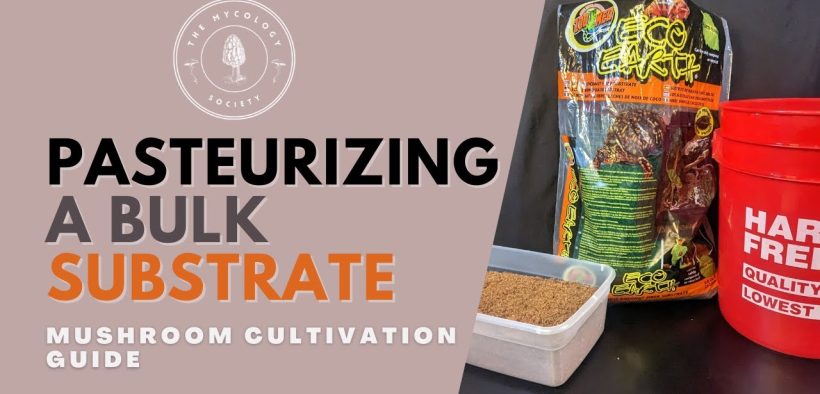Easy Bucket Tek Method Revealed | Mushroom Cultivation Guide KarambitKnives,com

Unlock the secrets of mushroom cultivation with our detailed guide on the Spawn to Bulk phase using the Easy Bucket Tek Method! In this video, we’ll walk you through every step of pasteurizing your bulk substrate with the bucket tek method, an essential process for preventing contamination and ensuring healthy mycelium growth. Whether you’re growing medicinal or gourmet mushrooms, this method is crucial for setting up your mushroom cultivation for success.
First, we’ll explain what pasteurization is and why it’s important for your bulk substrate. Then, we’ll dive into the materials you need—like Coco coir, a bucket, and boiling water—and show you exactly how to mix and prepare them. You’ll learn how to achieve the perfect Field capacity for your substrate, ensuring it has just the right amount of moisture to support robust mycelium growth without risking contamination.
By the end of this video, you’ll be equipped with all the knowledge you need to master the bucket tek method and move confidently to the next stage: spawning to bulk. Remember, this is a critical step in the mushroom cultivation process that can make or break your grow.
Subscribe to our channel for more mushroom cultivation tutorials, and don’t forget to check out our other videos for more tips and tricks. Watch now and become an expert in mushroom cultivation!
Essential tools and techniques covered:
– Importance of pasteurization for contamination prevention
– Step-by-step guide on achieving Field capacity
– Detailed breakdown of materials needed, like Coco coir and boiling water
– Tips for using grain spawn and ensuring healthy mycelium growth
Don’t miss out on this comprehensive guide—hit play and start your journey to successful mushroom cultivation today!
*KEY INSIGHTS*
🌱 The bucket Tech method is a simple and effective way to pasteurize bulk substrate for mushroom cultivation.
🌡️ The bucket tek method involves mixing Coco choir with boiling water, letting it cool, and then draining off the excess water to achieve field capacity.
🌱 Using loose Coco coir instead of bricks makes the preparation process much easier and more efficient for mushroom cultivation.
🍄 The bucket tek method for mushroom cultivation is a simple and straightforward process, no rocket science required.
💧 Field capacity is the perfect moisture content for your substrate and mushrooms, like the Goldilocks rule – not too much, not too little, just right.
🌱 Mixing grain spawn with colonized mycelium will result in the formation of a big substrate cake for mushroom growth.
📦 Moving on to the spawn to bulk phase is the next step in the process of mushroom cultivation, leading to the eventual growth of mushrooms.
*CHAPTERS*
*TLDR:* The bucket tek method is a simple and effective way to pasteurize bulk substrate for mushroom cultivation, making the preparation process easier and more efficient.
00:00 🍄 Pasteurize bulk substrate using the bucket Tek method to prevent contamination and grow medicinal mushrooms.
01:39 🍄 Use boiling water to pasteurize Coco coir in a bucket, then prepare for mushroom cultivation with 650g of Coco coir and 3.5 quarts of water, using Eco Earth for an affordable and reliable option.
04:13 🍄 Mix ingredients, heat, cool, drain, then follow mushroom cultivation recipe from well-known grower using boiling water and coir in a bucket.
06:20 🍄 Add water to substrate, balance moisture with coir, and achieve perfect moisture content for mushroom cultivation.
10:50 🍄 Squeezing excess water from coco coir, preparing for spawning colonized grain to pasteurized coco coir for mushroom cultivation, with field capacity having different consistency and color.
13:23 🍄 Mix spawn with coco coir, let it colonize for 2 weeks, then mushrooms grow off substrate cake, following speaker’s videos for quick 30-day process.
16:47 🍄 Mix colonized grain with pasteurized Coco choir in a bucket, then move to fruiting conditions for quick mushroom production.
18:41 🍄 Pasteurize your substrate, leave feedback, and subscribe for more mushroom cultivation tips and updates on the grow process.
#EasyMethod #Spawn #Mycology #BucketTek #BulkSubstratePrep
#BucketTek #CocoCoirPreparation #BulkSubstrate #Spawn #CultivatingMushrooms
source
KarambitKnives.com


Learn the next step in the mushroom cultivation process here: https://youtu.be/O9X0LuedLyE
I think his recipe was 650g coir with 350g vermiculite and 50g gypsum. That would probably balance the water.
You’re right: 650g is 650g
It's approximately 2 & 1/4 quarts (2.1 litres) of hot water per 650 gram brick of coir.
Did you find the ratio?
Use two buckets. Drill holes in the bottom of the one you're putting the coco coir in. Place a spacer in the bucket so the water can run through the first bucket and gather in the bottom of the second
Philly's recipe is 650g coco, 2 qts (8cups) of vermiculite, 1 cup of gypsum and 4.5 qts (18 cups) water.
Hi! Any chance you can post the ratio of water to ground coco coir? I do not know the channel you are referring to in the video.
The coir bricks may not be as convenient to use as the loose stuff, but I regularly use 650 gram bricks of coir with 4 cups of vermiculite (at least, it's easy just to eyeball it), and 3.5 to 4 quarts of very hot water. If the substrate (after soaking 4 to 5 hours) is still a bit wet, I just add a bit more vermiculite to get it to field capacity. It takes time, and a bit more work to ensure the coir is broken up and hydrated, but even with the added expense of vermiculite, I have found it to pretty much replicate sensei's bucket tek every time.
Always add less water than needed. If you need more then you add more boiling water to keep pasteurizing. If you add too much water then have to add more coco you’ve dropped the temperature and therefore are just hydrating and not pasteurizing.
650 grams of dry coir bricked is about 12 quarts of loose coco .
5 quarts of water is just about perfect for 650 grams of coco ✌
I bake my substrate in the oven at 140F for an additional 20 mintues. I live in a cold climate and the hot water is probably not pasteurizing much because the temp quickly drops inside the bucket.
Theres always contamination the goal is to minimize it
if the oryginal one was with gypsum you know why its soupy 😉
Turkey bag and pressure cooker. Simple and easy
Silk hose and a cheap sous vide heater from Ollies. You're welcome.
You're missing the 8 cups of verm, I do 1300g coir, 16 cups verm and 2 cup gypsum and I have found about 5.25qts of water to be the sweet spot
You need Vermiculite!!!
Suggestion for you. If you take accurate measurements of both your water and coco prior to the soak, then measure the amount of water you squeezed out to reach your ideal field capacity, you should be able to figure what your ideal no-squeeze water/coco ratio is. As long as you have the bucket lid on through the entire soak and no water is lost to evaporation, i think this should get you pretty close to dialed in. Hope this helps.
Nice thanks for the vid, what are you usinsing the substrate for is it oister ?